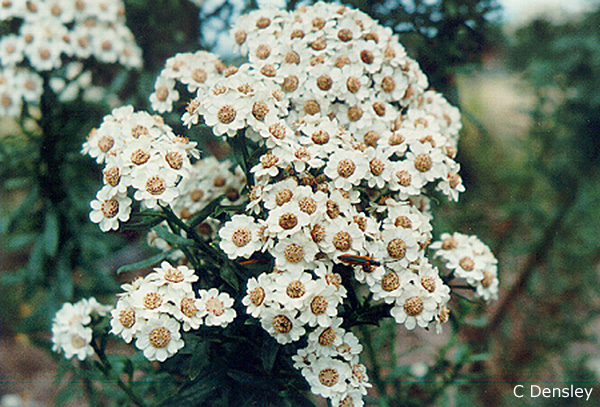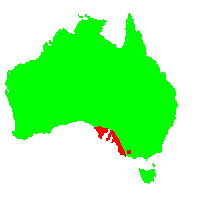General Description:
Ixodia is a small genus of two species. I achilleoides is the better known and more widespread species and is usually a small, perennial shrub but it can reach 2 metres in height. I.achilleoides consists of three recognised subspecies: ssp.achiilleoides, ssp.alata and ssp. arenicola, all occurring in South Australia with the latter two extending into coastal areas of far western Victoria. Ssp. alata is also found in the Grampians Ranges of western Victoria. The subspecies differ in the nature of the foliage and size of the flower heads.
The foliage of Ixodia achillaeoides is dark green in colour with linear to lance-shaped leaves from 5 to 100 mm long, often “sticky” to the touch. I.achilleoides ssp.alata can often be distinguished from the other subspecies by having pronounced “wings” down the stems, however, the prominence of the wings can vary. The flower heads occur in small to large clusters at the ends of the stems and individual flower heads vary from 5 to 15 mm in diameter. The flower colour is white and this is retained when the flowers are dried, making this species (particularly ssp.alata) a desirable species for floriculture. Flowering usually occurs in spring and summer. The species is often observed to regenerate in large numbers after bushfires.
I achilleoides is becoming more popular in cultivation, particularly for the cut and dried flower markets where commercial plantations of ssp alata are being established in Western Australia, South Australia and Victoria. These plantings are being developed to replace bush picking which is both unreliable and environmentally unsustainable. Considerable research is being undertaken to develop superior forms for these markets.
The species is also becoming more popular in home gardens where it is suitable as as a rockery plant, background shrub or container plant. It performs best in areas with a fairly dry summer climate and may be difficult to maintain in more humid districts. It prefers well drained, moist soils in a sunny position. In common with other perennial everlasting daisies, the plant may deteriorate after 3 – 4 seasons and annual pruning after flowering is suggested to help maintain vigour.
Propagation from seed can be unreliable. Cuttings of hardened, current season’s growth usually strike without difficulty.

Ixodia achillaeoides
Photo: Cherree Densley
 Australian Native Plants Society (Australia)
Australian Native Plants Society (Australia)